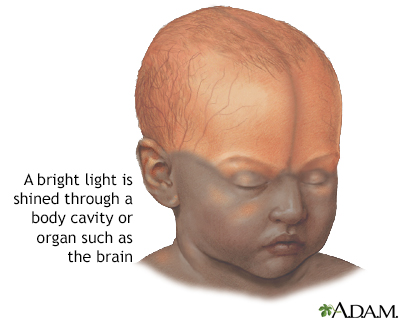Pregnancy SmartSiteTM
DefinitionTransillumination is the shining of a light through a body area or organ to check for abnormalities. How the Test is PerformedThe room lights are dimmed or turned off so that the area of the body may be seen more easily. A bright light is then pointed at that area. Areas where this test is used include the:
Transillumination is also sometimes used to find blood vessels. In some locations in the stomach and intestine, the light can be seen through the skin and tissues at the time of upper endoscopy and colonoscopy. How to Prepare for the TestNo preparation is necessary for this test. How the Test will FeelThere is no discomfort with this test. Why the Test is PerformedThis test may be done along with other tests to diagnose:
In newborns, a bright halogen light may be used to transilluminate the chest cavity if there are signs of a collapsed lung or air around the heart. (Transillumination through the chest is only possible on small newborns.) In general, transillumination is not an accurate enough test to rely on. Further tests, such as an x-ray, CT scan, or ultrasound, are needed to confirm the diagnosis. Normal ResultsNormal findings depend on the area being evaluated and the normal tissue of that area. What Abnormal Results MeanAreas filled with abnormal air or fluid light up when they should not. For example, in a darkened room, the head of a newborn with possible hydrocephalus will light up when this procedure is done. When done on the breast:
RisksThere are no risks associated with this test. ReferencesBall JW, Dains JE, Flynn JA, Solomon BS, Stewart RW. Examination techniques and equipment. In: Ball JW, Dains JE, Flynn JA, Solomon BS, Stewart RW, eds. Seidel's Guide to Physical Examination. 10th ed. St Louis, MO: Elsevier; 2023:chap 3. Lissauer T, Hansen A. Physical examination of the newborn. In: Martin RJ, Fanaroff AA, Walsh MC, eds. Fanaroff and Martin's Neonatal-Perinatal Medicine: Diseases of the Fetus and Infant. 11th ed. Philadelphia, PA: Elsevier; 2020:chap 28. | |
| |
Review Date: 8/20/2023 Reviewed By: Jacob Berman, MD, MPH, Clinical Assistant Professor of Medicine, Division of General Internal Medicine, University of Washington School of Medicine, Seattle, WA. Also reviewed by David C. Dugdale, MD, Medical Director, Brenda Conaway, Editorial Director, and the A.D.A.M. Editorial team. The information provided herein should not be used during any medical emergency or for the diagnosis or treatment of any medical condition. A licensed medical professional should be consulted for diagnosis and treatment of any and all medical conditions. Links to other sites are provided for information only -- they do not constitute endorsements of those other sites. No warranty of any kind, either expressed or implied, is made as to the accuracy, reliability, timeliness, or correctness of any translations made by a third-party service of the information provided herein into any other language. © 1997- A.D.A.M., a business unit of Ebix, Inc. Any duplication or distribution of the information contained herein is strictly prohibited. | |

 Infant brain test
Infant brain test
